Mapping subnational HIV mortality in six Latin American countries with incomplete vital registration systems
- PMID: 33413343
- PMCID: PMC7791645
- DOI: 10.1186/s12916-020-01876-4
Mapping subnational HIV mortality in six Latin American countries with incomplete vital registration systems
Abstract
Background: Human immunodeficiency virus (HIV) remains a public health priority in Latin America. While the burden of HIV is historically concentrated in urban areas and high-risk groups, subnational estimates that cover multiple countries and years are missing. This paucity is partially due to incomplete vital registration (VR) systems and statistical challenges related to estimating mortality rates in areas with low numbers of HIV deaths. In this analysis, we address this gap and provide novel estimates of the HIV mortality rate and the number of HIV deaths by age group, sex, and municipality in Brazil, Colombia, Costa Rica, Ecuador, Guatemala, and Mexico.
Methods: We performed an ecological study using VR data ranging from 2000 to 2017, dependent on individual country data availability. We modeled HIV mortality using a Bayesian spatially explicit mixed-effects regression model that incorporates prior information on VR completeness. We calibrated our results to the Global Burden of Disease Study 2017.
Results: All countries displayed over a 40-fold difference in HIV mortality between municipalities with the highest and lowest age-standardized HIV mortality rate in the last year of study for men, and over a 20-fold difference for women. Despite decreases in national HIV mortality in all countries-apart from Ecuador-across the period of study, we found broad variation in relative changes in HIV mortality at the municipality level and increasing relative inequality over time in all countries. In all six countries included in this analysis, 50% or more HIV deaths were concentrated in fewer than 10% of municipalities in the latest year of study. In addition, national age patterns reflected shifts in mortality to older age groups-the median age group among decedents ranged from 30 to 45 years of age at the municipality level in Brazil, Colombia, and Mexico in 2017.
Conclusions: Our subnational estimates of HIV mortality revealed significant spatial variation and diverging local trends in HIV mortality over time and by age. This analysis provides a framework for incorporating data and uncertainty from incomplete VR systems and can help guide more geographically precise public health intervention to support HIV-related care and reduce HIV-related deaths.
Keywords: HIV mortality; HIV/AIDS; Latin America; Mapping; Small area estimation; Spatial statistics; Vital registration.
Conflict of interest statement
Dr. Singh reports personal fees from Crealta/Horizon, Medisys, Fidia, UBM LLC, Trio health, Medscape, WebMD, Clinical Care options, Clearview healthcare partners, Putnam associates, Focus forward, Navigant consulting, Spherix, Practice Point communications, the National Institutes of Health and the American College of Rheumatology, personal fees from Simply Speaking, other from Amarin, Viking, Moderana and Vaxart pharmaceuticals, non-financial support from FDA Arthritis Advisory Committee, non-financial support from Steering committee of OMERACT, an international organization that develops measures for clinical trials and receives arm’s length funding from 12 pharmaceutical companies, non-financial support from Veterans Affairs Rheumatology Field Advisory Committee, non-financial support from Editor and the Director of the UAB Cochrane Musculoskeletal Group Satellite Center on Network Meta-analysis, outside the submitted work. Dr. Krishan reports grants from UGC Centre of Advanced Study, CAS II, awarded to the Department of Anthropology, Panjab University, Chandigarh, India, outside the submitted work. Prof. Postma reports grants and personal fees from various pharmaceutical industries, all outside the submitted work. Prof Postma holds stocks in Ingress Health and Pharmacoeconomics Advice Groningen (PAG Ltd) and is advisor to Asc Academics, all pharmacoeconomic consultancy companies. Dr. Ancuceanu reports he received consultancy and speakers’ fees from various pharmaceutical companies. Walter Mendoza is a Program Analyst in Population and Development at the United Nations Population Fund-UNFPA Country Office in Peru, an institution which does not necessarily endorse this study. Dr. Pandi-Perumal reports a non-financial relationship with Somnogen Canada Inc. and occasional royalities from publishing houses, outside the submitted work.
Figures
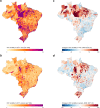
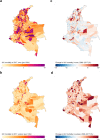
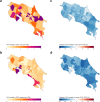

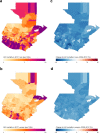


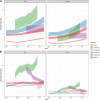

References
-
- Roth GA, Abate D, Abate KH, Abay SM, Abbafati C, Abbasi N, et al. Global, regional, and national age-sex-specific mortality for 282 causes of death in 195 countries and territories, 1980–2017: a systematic analysis for the Global Burden of Disease Study 2017. Lancet. 2018;392:1736–1788. doi: 10.1016/S0140-6736(18)32203-7. - DOI - PMC - PubMed
-
- Frank TD, Carter A, Jahagirdar D, Biehl MH, Douwes-Schultz D, Larson SL, et al. Global, regional, and national incidence, prevalence, and mortality of HIV, 1980–2017, and forecasts to 2030, for 195 countries and territories: a systematic analysis for the Global Burden of Diseases, Injuries, and Risk Factors Study 2017. Lancet HIV. 2019;6:e831–e859. doi: 10.1016/S2352-3018(19)30196-1. - DOI - PMC - PubMed
-
- Fast-Track - Ending the AIDS epidemic by 2030. https://www.unaids.org/en/resources/documents/2014/JC2686_WAD2014report. Accessed 24 Apr 2020.
-
- Joint United Nations Programme on HIV/AIDS. AIDSinfo. https://aidsinfo.unaids.org/. Accessed 24 Apr 2020.
Publication types
MeSH terms
Grants and funding
LinkOut - more resources
Full Text Sources
Other Literature Sources
Medical
Miscellaneous

